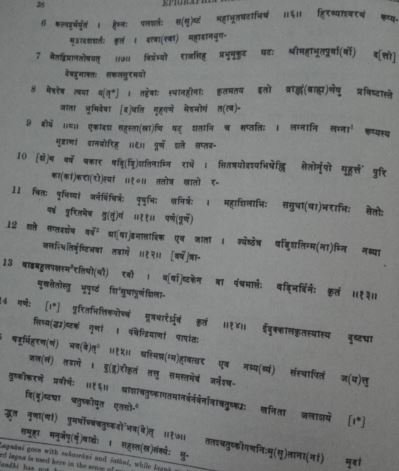| |
South
Indian Inscriptions |
| |
|
|
|
Contents |
|
Index
|
|
Introduction
|
|
Contents
|
|
List of Plates
|
|
Additions and Corrections
|
|
Images
|
|
Contents |
|
Chaudhury, P.D.
|
Chhabra, B.ch.
|
|
DE, S. C.
|
|
Desai, P. B.
|
|
Dikshit, M. G.
|
|
Krishnan, K. G.
|
|
Desai, P. B
|
|
Krishna Rao, B. V.
|
|
Lakshminarayan Rao, N., M.A.
|
|
Mirashi, V. V.
|
|
Narasimhaswami, H. K.
|
|
Pandeya, L. P.,
|
|
Sircar, D. C.
|
|
Venkataramayya, M., M.A.,
|
|
Venkataramanayya, N., M.A.
|
|
Index-By A. N. Lahiri
|
|
Other
South-Indian Inscriptions
|
|
Volume
1
|
Volume
2
|
|
Volume
3
|
Vol.
4 - 8
|
|
Volume 9
|
Volume 10
|
|
Volume 11
|
Volume 12
|
|
Volume 13
|
Volume
14
|
|
Volume 15
|
Volume 16
|
|
Volume 17
|
Volume 18
|
|
Volume
19
|
Volume
20
|
|
Volume 22
Part 1
|
Volume
22
Part 2
|
|
Volume
23
|
Volume
24 |
|
Volume
26
|
Volume 27 |
|
Tiruvarur
|
Darasuram
|
|
Konerirajapuram
|
Tanjavur |
|
Annual Reports 1935-1944
|
Annual Reports 1945- 1947
|
|
Corpus Inscriptionum Indicarum Volume 2, Part 2
|
Corpus Inscriptionum Indicarum Volume 7, Part 3
|
|
Kalachuri-Chedi Era Part 1
|
Kalachuri-Chedi Era Part 2
|
|
Epigraphica Indica
|
Epigraphia Indica Volume 3
|
|
Epigraphia
Indica Volume 4
|
Epigraphia Indica Volume 6
|
|
Epigraphia Indica Volume 7
|
Epigraphia Indica Volume 8
|
|
Epigraphia Indica Volume 27
|
Epigraphia Indica Volume 29
|
|
Epigraphia Indica Volume 30
|
Epigraphia Indica Volume 31
|
|
Epigraphia Indica Volume 32
|
Paramaras Volume 7, Part 2
|
|
Śilāhāras Volume 6, Part 2
|
Vākāṭakas Volume 5
|
|
Early Gupta Inscriptions
|
|
Archaeological
Links
|
|
Archaeological-Survey
of India
|
|
Pudukkottai
|
|
|
EPIGRAPHIA INDICA

_______________________________________________________________
[1] Lognāni goes with sahasrāṇi and śatāni, while lagnā qualifies saptatiḥ. It may further be observed that
the word lagna is used here in the sense of vyayita ‘spent’, which is more common in Hindī than in Sanskrit.
[2] Sandhi has not been observed here.
[3] The meaning of the word smara here seems to be five from the convention number of five assigned to the
arrows of Kāma.
[4] The letter śi is superfluous.
[5] There is a play upon the numbers mentioned in this stanza with reference to those of the date occurring in
verse 13 above. The six ūrmis are enumerated as śōka-mōhau jarā-mṛityū kshut-pipāsē shaḍ-ūrmayaḥ.
[6] Perhaps we have to read ēsha sō=dbhutō, referring to taḍāga or jalāśaya.
[7] Again a play on the number four, pumarth-ōchcha-chatushka means purushārtha-chatushṭaya : dharma, artha,
kāma, and mōksha.
|
\D7
![]()
|







